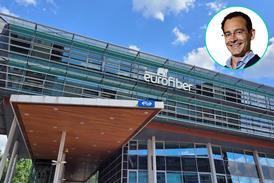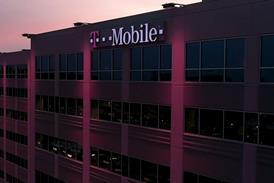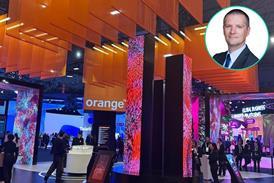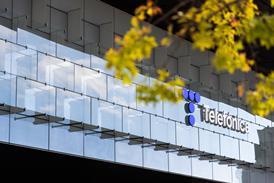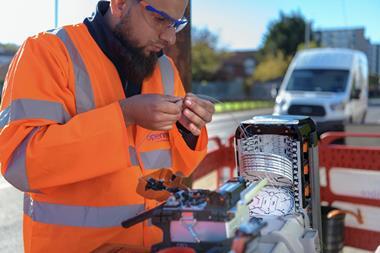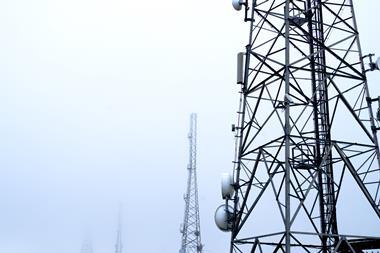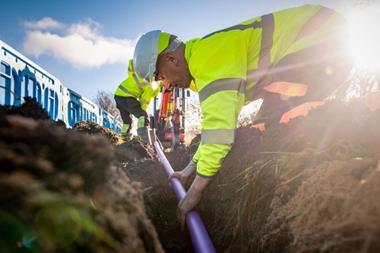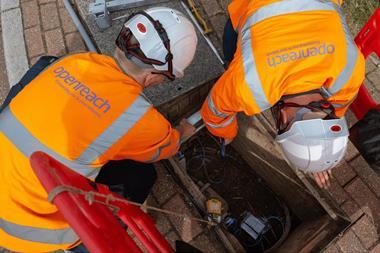- Group’s Q3 reflects a troubled three months of inflationary pressures, union challenge, and heightened competition.
- Promises made about coming Q4, with future more flashy than subdued Q3.
- Price hikes and build-rate earn most airtime.
- Philip Jansen happy with fibre build-out foundations, attention now on fuelling connections ‘machine’.
- BT Business announcement targets synergies, but bulk of benefits not expected in near-term.
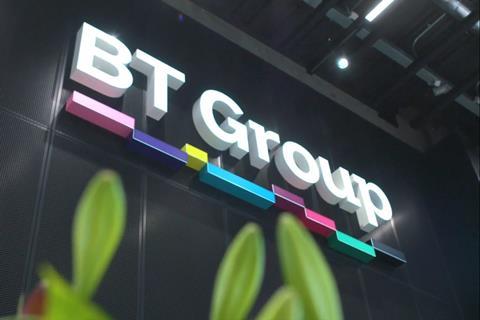

Despite a slight revenue drop, BT continued the course with only minor wobbles in its results for the third quarter and nine months to 31 December 2022 (Q3/9M FY22–23), as the fibre rollout continues to build a head of steam and customer demand keeps up.
The raw numbers suggest a broadly steady ship as Chief Executive Philip Jansen reaffirmed guidance and presented the operator as calm, despite “extraordinary” headwinds in the form of energy costs, inflation, and the now-quelled union storm. That is not to say BT does not continue to be dragged down by the usual business-to-business trouble, and the new challenge of the BT Sport siphoning-off meant pro forma figures were turned to as a more positive alternative to reported results.
These negatives were, by and large, offset by last year’s inflation-busting price hike and strong Openreach trading, with Jansen again drawing attention to the latter’s network build first and foremost.
A subdued Q3, but FY will finish with a flourish!
BT’s 9M saw revenue down 1% to £15.6bn, although pro forma figures present a 0.4% uptick of £65m. Q3 was broadly flat, down 0.1%.
Adjusted earnings before interest, taxation, depreciation, and amortisation (EBITDA) grew 3% to £5.9bn thanks in part to cost controls and the removal of BT Sport outlay. The revenue declines, however, offset some of that EBITDA growth, while inflationary pressures also played a part. Pro forma adjusted EBITDA was up 2%. Again, Q3 was largely flat, with a 0.6% increase.
Year-to-date post-tax profit ballooned 49% to £1.3bn, although pre-tax profit dropped 15% thanks to increased depreciation offsetting EBITDA growth.
Capex excluding spectrum grew 19% to £3.9bn, an uptick blamed on heavily front-ended spend at Openreach and is forecast to drop “significantly” in Q4. It was still rising in Q3, up nearly 15.6%.
This was an overriding theme of the results call — whether it was looking forward to Q4, or stepping back to get a multi-FY perspective, there appeared conscious efforts to divert attention from Q3 itself.
Where Q3 may have been stymied by strike action (Openreach lines down 10,000), competitive pressures (churn marginally up), and the now usual inflationary pressures, Jansen and Chief Financial Officer Simon Lowth wanted to leave an impression of BT moving towards its goals (costs, networks, and commercial), regardless of quarterly bumps in the road. Big picture, BT is trending positively, the pair claim, and the coming FY will prove that. BT Business bedding in, consumer brand changes for EE, and Equinox 2 pricing to drive the wholesale fibre proposition, to name a few things to come.
| Q3 FY21–22 | Q3 FY22–23 | Change | |
|---|---|---|---|
| Source: BT. | |||
|
Revenue |
£5,219m |
£5,212m |
-0.1% |
|
EBITDA |
£1,995m |
£2,007m |
0.6% |
|
EBITDA margin |
38.2% |
38.5% |
0.3pp |
|
Cash capex |
£1,163m |
£1,344m |
15.6% |
|
Normalised free cash flow |
£518m |
£42m |
-91.9% |
|
Net financial debt |
£11,911m |
£13,810m |
15.9% |
Full-fibre firing
“We’re building — and connecting — like fury”, said Jansen on more than one occasion, playing on his recent catchphrase, before adding a locomotive metaphor to the repertoire.
“ The FTTP initiative is now a runaway train both in terms of build and now in terms of connections. That’s what really matters: its that customers get connected to this new, fantastic network. ”
Jansen.
Openreach rolled out its FTTP infrastructure at an average of 62,000 premises per week, keeping pace with targets to reach three million per annum. Customer demand appears to be keeping up, too. Penetration is now at 29% (matching Virgin Media O2’s claimed 30% Gigabit uptake), and customer orders for full-fibre are up 51%. A key indicator, however, is how that fibre uptake is trending. Just shy of 50% of customers where the network was built two years ago have now made the switch, “supporting higher ARPU, delivering end customer satisfaction, and lowering operating costs”.
“ We have begun to industrialise our connections machine. ”
Jansen.
The bullish talk of fibre progress comes despite concessions that the downturn in the new build home market is impacting Openreach, and is set to continue to drag for the foreseeable.
Q3 also saw the unveiling of Equinox 2, the revamped wholesale pricing strategy that prompted fairly widespread criticism from competitors in late-2022 and early-2023. Although still under regulatory review, and not to be implemented until April should it get the go-ahead, Jansen boasted that “a number of major CPs [communication providers] have given a statement of intent to sign up”. No specifics were given, either on numbers or the progress of regulatory wrangling to get it through, but the Group CEO was vocal about his expectation that Equinox 2 will deliver.
Discounted pricing in the new Equinox proposal may help with wholesale customer uptake. In Q3, Consumer’s share of Openreach fibre net adds was three percentage points higher than the year prior, at 47%.
BT Business: one problem child is better than two
Q3’s biggest news, perhaps, was the formation of BT Business — bringing together Enterprise and Global into a single entity under the BT brand. The two divisions continue to report distinctly for now, but have merged operationally as of January and will be rolled up into a single spreadsheet from the start of the next FY.
The merger aims to “enhance value” for customers while promoting a single, strengthened unit to fend off B2B competition. £100m in cost-savings is part of the package and “material synergies” are expected.
For now, and by Jansen’s admission for some time into the future, the B2B market remains a challenge. Revenue for both units is down, although with an improved trend at Enterprise, while EBITDA dropped 13% at Enterprise and was flat at Global. Enterprise managed steady progress in its VoIP take-up, and 4% order book growth to take £2.8bn on a twelve-month rolling basis.
At Global, the ‘growth’ product portfolio reached a milestone to represent more than 50% of the division’s total orders in the year, albeit from an order book that has contracted a further 10% in the past twelve months to £2.9bn.
Consumers getting what they’re paying for
At Consumer, talk from both management and analysts in the subsequent Q&A revolved almost exclusively around price rises.
Jansen, in the mood to set the record straight despite the best efforts of Customer Services MD Nick Lane earlier in the year, accepted that “no one celebrates price increases”, while continuing to assert that BT customers “understand them”.
Mention of Ofcom’s investigation into BT’s contract transparency was an inevitability, given its recency, and Jansen was sure to present the Group’s relationship with the regulator as a positive one. “We’re engaged with Ofcom on multiple fronts all the time. It’s a really important relationship, given what’s happening at our business and in the industry at large”, he said.
He appeared confident that the regulator will come out on BT’s side in the matter of contract transparency, but analysts probing the matter suggests not all are convinced.
Consumer looks best from a networks perspective. 5G coverage has reached 60% of the UK population, and the loosely-defined “5G ready” customer base has surpassed 8.5 million, up from 8.2 million at the end of Q2. Consumer’s fibre base grew to 1.6 million, up a further 155,000.
Problem areas include fixed-mobile convergence, which got a mention only briefly on the results call and continues to stagnate at around 21%, where it has sat for the past few FYs. Another is churn, up marginally among fixed customers.
Consumer revenue was flat at £2.4bn, with EBITDA up just shy of 1% to £669m. Jansen pointed to a fall in handset sales as a factor in this, with consumers holding onto devices for longer, partly a symptom of the so-called cost-of-living crisis.
| Q3 FY21–22 | Q3 FY22–23 | Change | |
|---|---|---|---|
| Source: BT. | |||
|
Group revenue |
£5,219m |
£5,212m |
-0.1% |
|
Consumer |
£2,435m |
£2,439m |
0.2% |
|
Enterprise |
£1,295m |
£1,253m |
-3.2% |
|
Global |
£871m |
£857m |
-1.6% |
|
Openreach |
£1,361m |
£1,419m |
4.3% |
|
Group EBITDA |
£1,995m |
£2,007m |
0.6% |
|
Consumer |
£663m |
£669m |
0.9% |
|
Enterprise |
£400m |
£350m |
-12.5% |
|
Global |
£114m |
£114m |
0.0% |
|
Openreach |
£807m |
£859m |
6.4% |
Q3 FY22–23: no frills at BT, but fireworks to come before the year’s up

BT’s Q3 reflects a troubled three months of inflationary pressures, union challenge, and heightened competition.
 Currently
reading
Currently
reading
Q3 FY22–23: no frills at BT, but fireworks to come before the year’s up
- 2
- 3
- 4







